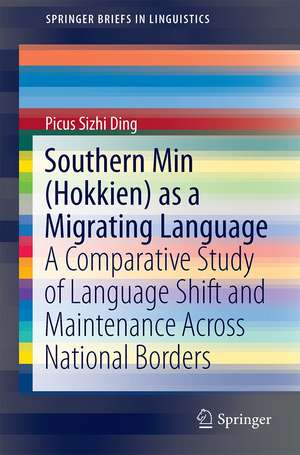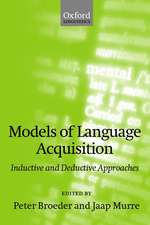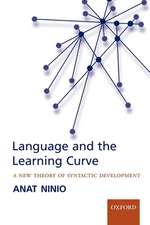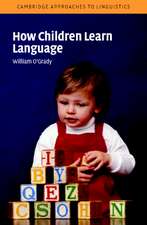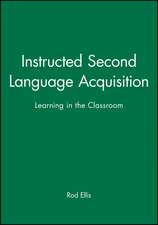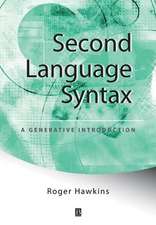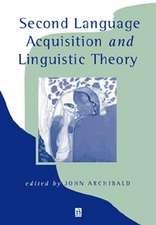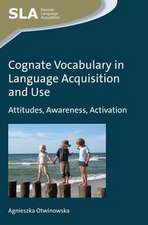Southern Min (Hokkien) as a Migrating Language: A Comparative Study of Language Shift and Maintenance Across National Borders: SpringerBriefs in Linguistics
Autor Picus Sizhi Dingen Limba Engleză Paperback – 24 noi 2015
Din seria SpringerBriefs in Linguistics
-
 Preț: 377.73 lei
Preț: 377.73 lei - 15%
 Preț: 461.54 lei
Preț: 461.54 lei -
 Preț: 377.35 lei
Preț: 377.35 lei -
 Preț: 476.95 lei
Preț: 476.95 lei -
 Preț: 378.71 lei
Preț: 378.71 lei -
 Preț: 476.21 lei
Preț: 476.21 lei -
 Preț: 378.92 lei
Preț: 378.92 lei -
 Preț: 378.92 lei
Preț: 378.92 lei -
 Preț: 378.54 lei
Preț: 378.54 lei -
 Preț: 448.58 lei
Preț: 448.58 lei -
 Preț: 412.30 lei
Preț: 412.30 lei -
 Preț: 379.86 lei
Preț: 379.86 lei -
 Preț: 410.01 lei
Preț: 410.01 lei -
 Preț: 376.80 lei
Preț: 376.80 lei
Preț: 378.92 lei
Nou
Puncte Express: 568
Preț estimativ în valută:
72.51€ • 75.89$ • 60.35£
72.51€ • 75.89$ • 60.35£
Carte tipărită la comandă
Livrare economică 31 martie-14 aprilie
Preluare comenzi: 021 569.72.76
Specificații
ISBN-13: 9789812875938
ISBN-10: 981287593X
Pagini: 70
Ilustrații: XIV, 109 p. 20 illus. in color.
Dimensiuni: 155 x 235 x 10 mm
Greutate: 0.2 kg
Ediția:1st ed. 2016
Editura: Springer Nature Singapore
Colecția Springer
Seria SpringerBriefs in Linguistics
Locul publicării:Singapore, Singapore
ISBN-10: 981287593X
Pagini: 70
Ilustrații: XIV, 109 p. 20 illus. in color.
Dimensiuni: 155 x 235 x 10 mm
Greutate: 0.2 kg
Ediția:1st ed. 2016
Editura: Springer Nature Singapore
Colecția Springer
Seria SpringerBriefs in Linguistics
Locul publicării:Singapore, Singapore
Public țintă
ResearchCuprins
1. Introduction.- 2. Multilingualism in drifting families.- 2.1 The overall migration history of a Hokkien family.- 2.2 The first generation: from Hokkien to Burma.- 2.3 Case I in the second generation: from Burma to Macao.- 2.4 Case II in the second generation: from Burma to U.S.A.- 2.5 Case III in the second generation: from Burma to Macao.- 2.6 Multilingualism and bilingualism in the families.- 2.7 Hokkien as a legacy of the drifting families.- 3. The rise and fall of Hokkien in Singapore.- 3.1 The glorious days of Hokkien in Singapore.- 3.2 Effects of language policy: the Speak Mandarin Campaign.- 3.3 Bilingualism in the new generation of Hokkien Singaporeans.- 3.4 The current status of Hokkien in Singapore.- 4. Taiwan: the haven for Hokkien?.- 4.1 The spread of Hokkien from Fujian to Taiwan.- 4.2 Loss of dominant status to Japanese and Mandarin.- 4.3 Language revitalization in Taiwan: reconstructing multilingualism.- 4.4 The future of Hokkien in Taiwan.- 5. The fate of Hokkien in its homeland.- 5.1 The status of Hokkien since 1949.- 5.2 Promotion of Mandarin in mainland China.- 5.3 Hokkien as an endangered topolect under transitional bilingualism.- 6. Conclusion.
Caracteristici
Casts light on the understanding of multilingualism as a result of social adaptation Reveals the connection between transitional bilingualism and language shift Provides detailed accounts of how Hokkien (Southern Min) faded away in migrating families and Hokkien-speaking territories Includes supplementary material: sn.pub/extras
